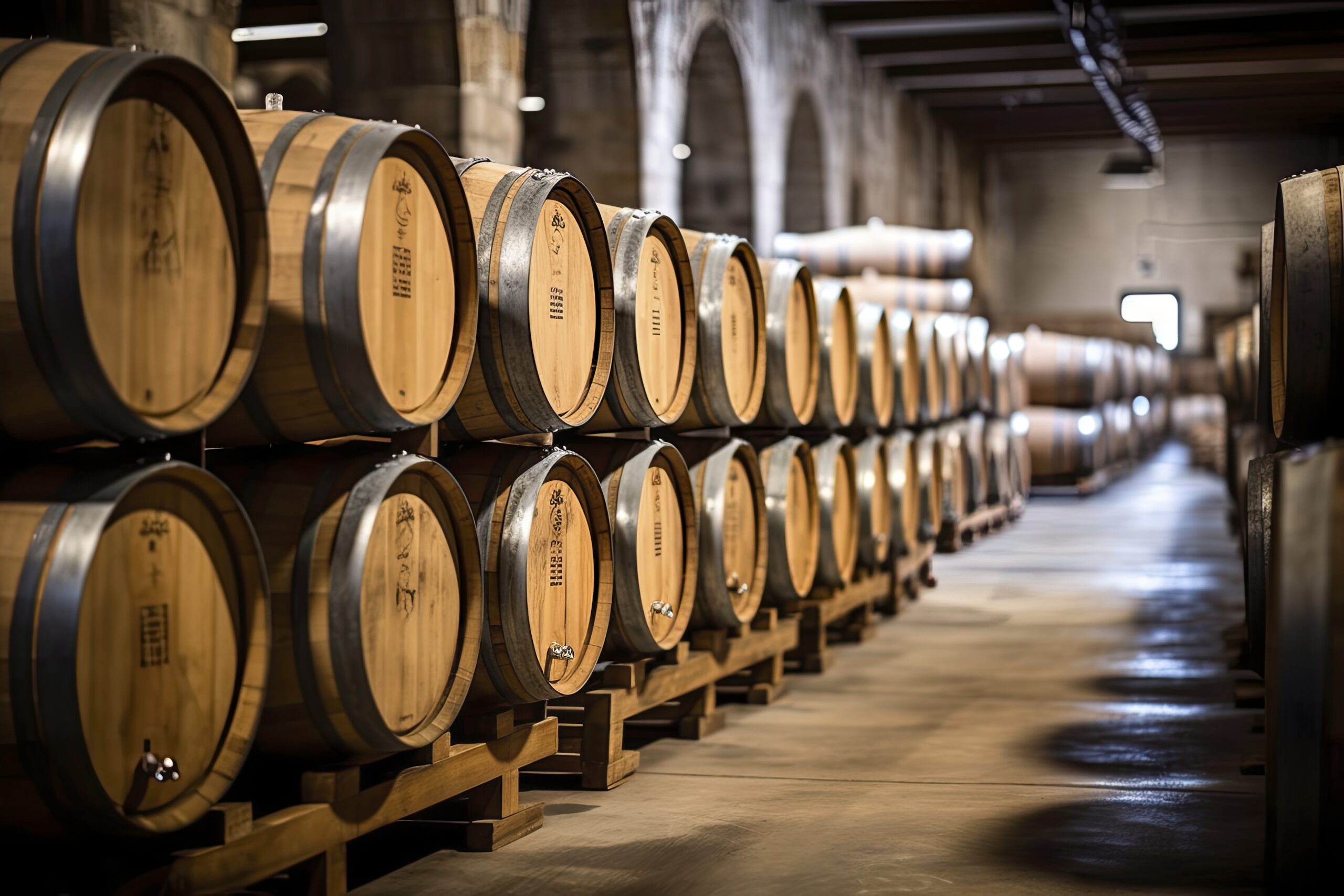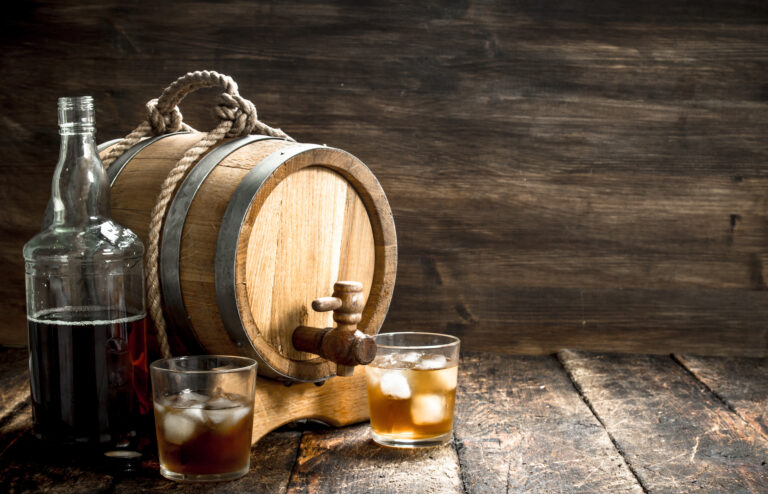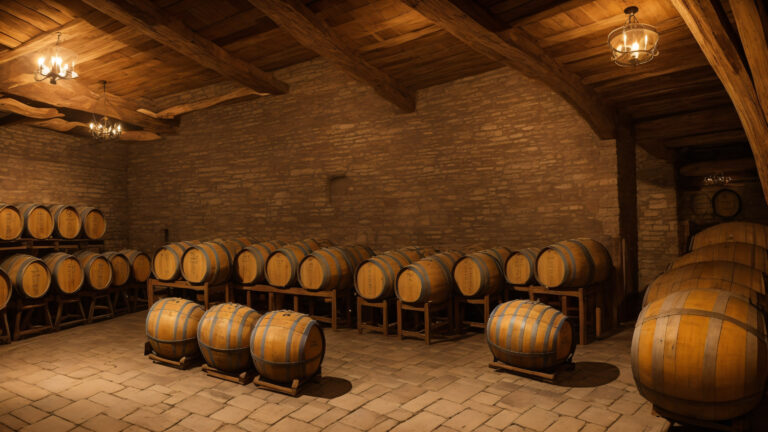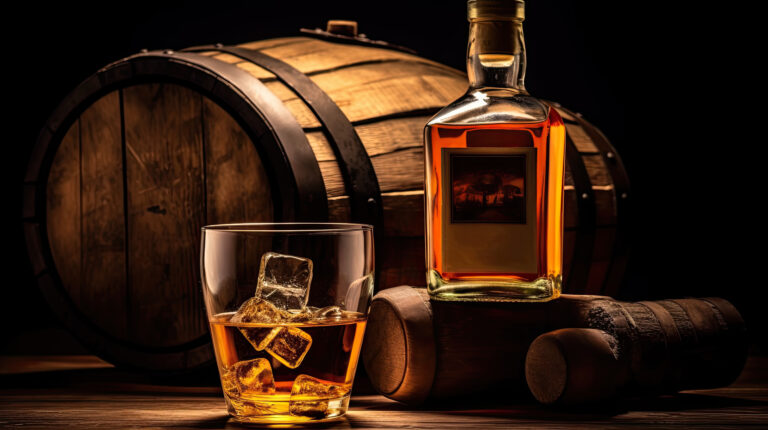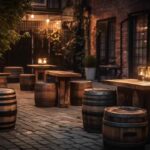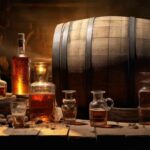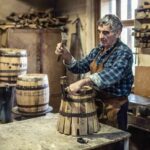Ever wondered what it really costs a distillery to transform raw spirit into that smooth, aged whiskey, brandy, or rum you love? It’s a wild ride of expenses, especially when you factor in Father Time himself. Think about it: as that precious liquid mellows for years, sometimes even decades, distilleries have a ton of cash tied up in inventory that’s just… chilling. No revenue, just anticipation. That’s why those beautifully aged bottles often come with a heftier price tag than their unaged buddies – all those hidden costs have to be recouped!
Introduction to Barrel Aging and Its Price Tag
Barrel aging spirits like whiskey, bourbon, scotch, brandy, and rum demands a serious financial commitment from distilleries. Those beautiful wooden vessels, the oak barrels, can set them back anywhere from $100 to a cool $1000 each, depending on the type of wood and barrel size. And then there’s the monumental cost of storage space, as these barrels are surprisingly greedy when it comes to square footage during the long aging process.
The Investment in Barrels: A Deep Dive
Let’s be real, the barrels themselves are the big-ticket item in the barrel aging equation. Distilleries predominantly rely on oak barrels, typically choosing between American oak or French oak. American oak barrels tend to be a bit more budget-friendly, usually in the $200-$500 range. French oak barrels, however, can easily hit $500-$1000 each. Why the difference? French oak often boasts a tighter grain, which subtly impacts the flavor profile of the spirit. Naturally, bigger barrels mean bigger price tags. And here’s the kicker: these barrels aren’t forever. They typically need replacing every few years as they lose their integrity and flavor-imparting magic, making this an ongoing, not a one-time, expense in the world of spirit production.
The Real Estate of Aging: Warehouse Costs
Imagine trying to store hundreds of thousands of barrels – that’s what barrel aging demands! Each barrel, on average, hogs about 50 cubic feet of space. For a nimble craft distillery with a few hundred barrels, a large garage might do the trick. But for a behemoth distillery with hundreds of thousands of barrels? We’re talking about constructing and maintaining enormous barrel warehouses, often called rickhouses. This massive real estate investment comes with its own set of bills: construction costs, meticulous temperature and humidity control systems, robust security, and, of course, the ever-present expense of staffing to manage it all. These are crucial elements in ensuring consistent spirit quality.
The Ultimate Cost: Time
Perhaps the most underrated cost of barrel aging is plain old time. Most premium spirits demand aging periods of 3 to 30+ years, sometimes even longer, before they’re deemed ready for bottling. For that entire duration, the product just sits there, patiently waiting, not generating a single dime of revenue. It’s essentially a significant opportunity cost – the distillery is losing out on the potential interest or returns that capital could have generated if invested elsewhere. However, this seemingly idle period is where the magic happens; barrel aging allows the product to develop incredible complexity and ultimately, higher market value. Finding that sweet spot between investment and a perfected product is the distiller’s delicate dance.
With substantial outlays for oak barrels, vast warehouse space, and the sheer investment of time, barrel aging is far from a cheap process. Yet, for countless distilleries, the resulting premium, aged spirit is absolutely worth every penny. By shrewdly managing production costs and maximizing efficiency, distilleries can still turn a healthy profit from this time-honored tradition of spirit maturation.
The Price Tag of New Oak Barrels
The initial splurge on new oak barrels is undeniably one of the heftiest expenses for distilleries committed to aging spirits. New American oak barrels typically range from $200 to $1000 each, with the exact price tag swinging based on the barrel size and the wood source.
The better the oak quality, the deeper you dig into your pockets. For instance, barrels crafted from oak sourced in regions like Kentucky and Missouri, renowned for their ideal climate and soil conditions that produce tight-grain wood, are highly coveted for aging spirits. These top-tier oak barrels can easily cost two to three times more than standard options, a testament to their impact on spirit flavor.
Many a discerning distiller prefers barrels made from oak that’s been patiently air-dried for 6-18 months. While kiln-dried oak is certainly cheaper, it can, unfortunately, impart harsher, less nuanced flavors. Air-drying is a slower, more natural process that consistently results in smoother, more mellow flavor development in the spirit.
The initial financial commitment to barrels is significant, particularly for nimble craft distilleries. But here’s the good news: barrels can often be put through 3-5 aging cycles before they truly lose their ability to impart those desirable flavor and aroma compounds. Some distillers even push their barrels to 12 uses, though this is less common for bourbon production.
It’s a fact: with each subsequent use, the barrel’s influence on the spirit gradually wanes. This is why many distillers cleverly use a blend of new and used barrels to strike a perfect balance between managing costs and achieving the desired flavor impact in their final product.
As spirits age, a portion of the liquid inside inevitably evaporates. This poetic loss is famously known as the “angel’s share” and typically accounts for a 2-6% volume reduction per year. While the evaporated alcohol and water certainly intensify the flavor of the remaining liquid, it also means less product to bottle and sell, impacting overall yield.
Maintaining optimal storage conditions is paramount for maximizing barrel lifespan. Storing barrels in a cool, humid warehouse helps minimize damage from environmental factors. Regular barrel rotation and periodic topping off also play a crucial role in preserving the barrels and their precious contents.
Given the substantial upfront cost of barrels and the ongoing expenses like evaporation loss, aging spirits is definitely not a get-rich-quick scheme. But for many distillers and passionate consumers, the ultimate reward – a complex, richly flavored spirit – makes the investment entirely worthwhile. The secret sauce lies in strategically balancing cost-effectiveness with quality control to ensure distillers can still turn a profit in the long run.
The Footprint of Flavor: Space Needed for Barrel Warehouses
Barrel aging demands a considerable amount of real estate for barrel warehouses (also known as rickhouses) to house the barrels during their lengthy aging process. As a distillery’s production volume grows, so too does the need for expanded warehouse space to accommodate the increasing number of barrels. These rickhouses must be meticulously designed and constructed to provide the precise environmental conditions essential for proper barrel aging of spirits.
Temperature Control: The ambient temperature within the rickhouse plays a critical role in how quickly the spirit ages and develops its intricate flavor profile. Warmer temperatures generally accelerate the aging process, while cooler temperatures gently slow it down. The location, the chosen building materials, and the sophistication of the ventilation system all significantly influence the internal temperature fluctuations. Distilleries must constantly monitor these temperatures to ensure the maturation process progresses exactly as intended for optimal spirit development.
Humidity: The humidity level within the rickhouse is another crucial factor influencing aging dynamics. Higher humidity encourages spirits to extract more nuanced flavors from the barrel wood, while lower humidity leads to less interaction between the spirit and the barrel. Distilleries must meticulously regulate humidity through a combination of effective ventilation, controlled heating, and the strategic selection of building materials. For instance, traditional wooden rickhouses often combined with metal or slate roofs tend to maintain more consistent humidity levels compared to those utilizing asphalt or tar roofs, directly impacting spirit quality.
Air Circulation: Stagnant air is the enemy of full spirit development during barrel aging. Continuous airflow around the barrels allows the spirits to “breathe” and efficiently extract those vital flavors from the wood. Thoughtfully placed vents, strategically opened windows, powerful fans, and natural convection currents all facilitate robust air circulation within the rickhouse. Generally, the more effective the air circulation, the faster the spirits tend to age, though finding the right balance is key to optimal flavor extraction.
Barrel Storage: Rickhouses must offer ample space for barrels to be properly stored on their sides during the aging period. Barrels are typically stacked two to five high on sturdy wooden pallets – this isn’t just for convenience, it’s vital for crucial air circulation and ease of movement during barrel management. Adequate aisle space between barrel stacks is also non-negotiable for efficient monitoring, barrel rotation, and the eventual retrieval of barrels. As additional barrels are filled, more rickhouse space is inevitably required to age the spirits to their full maturity.
For distilleries, providing sufficient, meticulously controlled space for barrel aging represents a serious financial investment. However, it is an absolutely essential pillar for producing truly premium, aged spirits. Meticulous planning and intelligent design of rickhouses allow distilleries to maximize quality while simultaneously optimizing costs in this intricate dance of spirit maturation.
The Vanishing Act: Evaporation Rates and the “Angel’s Share”
The longer whiskey hangs out in barrels, the more it mysteriously disappears into thin air due to evaporation. This ethereal loss is famously dubbed the “angel’s share,” and it typically accounts for roughly 2-4% of the barrel’s volume each year. While that might sound like a small percentage, over the course of 5-20 years, it truly adds up, significantly cutting into potential profits and impacting yield.
The True Cost of Barrels: Let’s reiterate, the barrels themselves are a massive capital outlay for distilleries. A single new charred oak barrel can run anywhere from $200-$500, and a major distillery might have hundreds of thousands of barrels patiently aging at any given moment. Even used barrels demand constant maintenance and upkeep to prevent leaks. When you factor in the time value of money, this represents a substantial ongoing financial burden in the spirit production cycle.
Warehouse Overhead: Those barrels need a home for years, a consistently temperature and humidity-controlled environment. This necessitates warehouses, sophisticated security systems, climate control equipment, proper lighting, and a dedicated staff to monitor everything – all of which come with a hefty price tag. Rent, insurance, and property taxes on these expansive warehouses also have to be meticulously factored into the operating costs.
Opportunity Cost: Tying up a significant chunk of liquid capital in the form of distilled spirits for an extended period means missing out on other potential financial gains. There’s a very real opportunity cost to consider, in the form of interest and returns that could have been generated if those funds weren’t invested in aging whiskey. This is a critical consideration for cash flow management in the distillery business.
While the angel’s share and the associated costs of barrel aging definitely pose financial hurdles, this practice is absolutely vital for developing the unique and sought-after flavor profiles that consumers expect in aged spirits. Finding smart ways to minimize loss and maximize efficiency, such as strategic barrel rotation and innovative blending techniques, can help make the economics of barrel aging work. The immense potential rewards of producing a truly premium, aged spirit ultimately make navigating these challenges worthwhile for many distilleries.
The Human Touch: Labor for Barrel Management
Labor, as we all know, is one of the biggest costs for practically any business, and distilleries are definitely no exception. Barrel aging demands constant, hands-on monitoring and meticulous maintenance, all of which require significant staff time and dedicated resources. These are the unsung heroes of spirit maturation.
Racking and Rotation: As the whiskey slowly ages, the barrels aren’t left in one spot; they need to be precisely racked (moved) and strategically rotated. This ensures even aging across the entire batch and, crucially, prevents the whiskey from picking up any undesirable off-flavors. Moving full barrels is tough, physically demanding work that requires multiple dedicated employees and strict adherence to safety equipment protocols.
Sampling: To meticulously check on the progress of aging and make informed decisions about when to bottle, samples must be carefully drawn from barrels. This is a skilled, manual process using a specialized tool called a “whiskey thief” to extract small amounts from each barrel. These precious samples then undergo rigorous nosing and tasting by highly skilled experts to determine the quality and readiness of the spirit. This labor-intensive process demands experienced and discerning employees.
Maintenance: The barrels themselves aren’t set-it-and-forget-it; they require ongoing maintenance to prevent leaks and ensure quality control. Periodically, barrels need to be thoroughly inspected, meticulously re-caulked, or have their hoops tightened. Leaky or improperly sealed barrels can lead to significant product loss, serious quality issues, and even dangerous workplace hazards. Proactive preventative maintenance helps avoid these costly problems but, you guessed it, requires dedicated staff to perform inspections and necessary repairs.
Blending and Bottling: Once barrels are deemed perfectly ready for bottling, the intricate and lengthy process of blending, filtering, and bottling begins. This phase demands skilled equipment operation, strict adherence to quality control procedures, diligent bottling line maintenance, and careful packaging – all of which rely heavily on a well-trained workforce.
When you add up all the labor costs associated with barrel management, including wages, benefits, continuous training, and more, it can represent a substantial portion of a distillery’s operating budget. However, when executed properly by knowledgeable and skilled staff, the results are undeniably worth the investment. The unwavering care and genuine craft that goes into managing barrels throughout the aging process is what ultimately transforms raw distillate into truly exceptional aged spirits.
The Tax Man Cometh: Taxes on Aged Spirits
As a distillery, one of your heftiest financial burdens will undoubtedly be the taxes on the spirits you produce. And guess what? Barrel aging adds another layer of complexity to figuring out your tax liability. Simply put, the longer a spirit ages, the higher the taxes tend to climb.
Federal Excise Taxes: The Alcohol and Tobacco Tax and Trade Bureau (TTB) is the big kahuna here, levying a federal excise tax on distilled spirits. This tax is paid twice: once when the barrels are initially filled, and again when the spirits are finally bottled. For most distilleries, the current tax rate is $13.50 per proof gallon. It’s worth noting that the tax is slightly higher for larger distilleries, while smaller, craft distilleries often benefit from a reduced rate on their first 100,000 proof gallons. As spirits age, some of the liquid inevitably evaporates—this is that familiar “angel’s share.” Here’s the kicker: even though you’re bottling less actual liquid, you’re still paying taxes based on the original barrel fill amount, which can sting!
State Taxes: In addition to federal taxes, almost every state also slaps on an excise tax on distilled spirits. These state tax rates vary wildly, but they average around $5 per gallon. Some states, in a bid to support local businesses, offer tax credits or incentives specifically for in-state distilleries. However, it’s crucial to remember that these state tax credits do not apply to the federal excise taxes.
Maximizing Profit: To truly maximize your profits from barrel aging, you need to pinpoint that elusive “sweet spot” – the ideal time to bottle the spirits. This involves a delicate balancing act between your tax liability, overall production costs, and the potential retail price you can command. As a general rule of thumb, the older the spirit and the higher its proof, the higher its potential retail price. However, aging for too long means losing more product to evaporation and, consequently, paying more in taxes on that lost volume.
By keenly understanding the tax implications and intricate costs associated with barrel aging, you can make truly strategic decisions to keep your distillery profitable. Meticulously tracking evaporation losses and optimizing aging times can significantly help minimize the tax impact. And, if you’re just starting out or considering expansion, choosing a strategic state to locate your distillery might unlock valuable tax incentives not available elsewhere. With some savvy business practices and a keen eye on the numbers, your distillery can successfully turn a profit from the art of barrel aging.
The Long Game: Marketing Costs for Older Spirits
Marketing spirits that have been lovingly aged for many years demands a boatload of patience and a significant financial investment. Unlike their younger counterparts that can be bottled and sold within a mere few months or years of distillation, aged spirits might need to literally sit in barrels for decades before they’re finally ready for market. This represents a monumental opportunity cost for the distillery; they’ve already poured capital into distillation equipment, barrels, storage space, and other operational costs, yet they can’t realize a single dime of revenue from those aged spirits for an incredibly long time.
Lost Interest and the “Angel’s Share” Revisited: As spirits patiently age in the barrel, a portion of that precious liquid inevitably evaporates—this is, of course, the infamous “angel’s share.” This ghostly loss typically amounts to about 2-4% of the barrel’s contents each year, the precise figure depending on environmental factors like temperature, humidity, and air circulation within the rickhouse. This isn’t just an abstract concept; it represents actual lost product that the distillery can never recover or sell, directly impacting profit margins. Compounding the issue, the remaining spirit also experiences a slight volume reduction due to absorption into the wood of the barrel itself.
The Art of Patience: Waiting for the Right Moment: Knowing exactly when spirits have aged sufficiently to bottle and command a premium price point is a blend of hard-earned experience and pure instinct. Bottle it too early, and the distillery risks missing out on additional flavor complexity and quality development that more time in the barrel might have provided. Wait too long, however, and you risk further reducing your yield (more angel’s share!) and potentially missing the peak moment to capture the full market value. Determining that perfect, fleeting window to pull barrels from aging and bottle their contents is part art, part science, and a major factor in profitability.
Higher Costs, Higher Risks: Those additional years of aging also inevitably inflate costs in other critical areas like barrel maintenance, continuous monitoring, meticulous sampling, and the ongoing expense of storage space. There are simply more opportunities for unforeseen mishaps – spills, leaks, or other accidents – that could negatively impact yield and spirit quality. The longer a spirit ages, the higher the inherent risks and the greater the costs involved—but, crucially, also the potential for a far greater reward, provided the distillery bottles and markets those aged spirits at just the right moment for maximum impact and brand value.
Balancing these multifaceted factors demands a long-term business perspective and a genuine willingness to temporarily sacrifice immediate short-term gains for the compelling possibility of higher long-term profits and a coveted premium brand position. When executed flawlessly, the economics of barrel aging can be incredibly rewarding. But let’s be clear, there are no guarantees, and it may require many years of dedicated aging, diligent experimentation, and continuous learning before a distillery truly masters the elusive formula for consistently producing exceptional, profitable aged spirits.
The Payoff: Potential Revenue From Aged Spirits
Once the extensive aging process is finally complete, distilleries can potentially see a rather delightful revenue boost from their aged spirits. The longer a spirit patiently ages, the more intricate and nuanced its flavor profile becomes, and consumers are often more than willing to pay a premium price for that enhanced and sophisticated taste experience.
Price Premiums: Aged spirits like bourbon, rum, and tequila can command significantly higher price points than their unaged counterparts. For example, a standard bottle of unaged white rum might retail for a modest $15-$20. Compare that to a well-aged rum like Zacapa 23, which might sell for $40 or more. The price difference becomes even more dramatic for aged tequila, where a bottle of unaged blanco tequila might cost $20-$30, while an extra añejo version could easily fetch $60-$100 or even more. This stark price differentiation highlights the value consumers place on spirit maturation.
Limited Releases: Some distilleries strategically release special limited edition aged spirits. These can generate extra revenue through the powerful combination of scarcity and generated hype. Only a small batch is produced, making quantities truly limited, and the spirit is often perceived as a coveted collector’s item. Examples include unique aged bourbons, rums, or tequilas aged for exceptionally long periods or in particularly unique barrels (e.g., wine barrel finishes). These limited releases offer an excellent opportunity for distilleries to significantly raise brand awareness and, crucially, charge premium prices.
Tourism Potential: A distillery boasting a diverse range of exquisite aged spirits possesses significant potential to draw in visitors eager for immersive tours, guided tastings, and the unique opportunity to purchase bottles directly from the source. Many craft distilleries have found immense success in building a robust tourism business around their operations, especially when they offer unique, aged spirits that can only be purchased exclusively at the distillery. Revenue streams here include tour tickets, tasting fees, robust on-site bottle sales, and branded merchandise.
While the aging process undeniably demands patience, time, and a substantial upfront investment, aged spirits can provide craft distilleries a clear pathway to higher profit margins and cultivate fierce brand loyalty. With strategic pricing, captivating limited releases, and an unforgettable distillery experience, aged spirits may very well prove to be liquid gold in the long run for your spirit business.
The Economics of Barrel Aging: Can Distilleries Really Turn a Profit? FAQs
Barrel aging spirits like bourbon and rum allows distilleries to craft truly premium products, but let’s be honest, the process demands significant upfront investment and a healthy dose of patience. Many smaller distilleries grapple with the tricky economics of barrel aging and whether they can genuinely turn a profit. Here are some of the most frequently asked questions about the substantial costs involved and how to make the numbers work in this fascinating corner of the spirits industry.
How much do barrels actually cost? New charred oak barrels can set you back anywhere from $200 to $1000 each, depending on the specific barrel size and the wood source. Most distilleries overwhelmingly prefer American white oak for its distinct flavor contributions. It’s a fact: barrels represent the single biggest upfront cost in the entire barrel aging process.
How much spirit is lost to evaporation? This is the famous “angel’s share,” the portion of the spirit that mysteriously evaporates during aging. The exact amount depends on a cocktail of factors like barrel size, wood type, the storage location within the rickhouse, and the overall aging duration. On average, distilleries can expect to wave goodbye to 2-5% of the barrel volume each year due to evaporation. For spirits that are aged for longer periods, the total loss over time can be a staggering 15-30% or even more, directly impacting yield and profitability.
How long do barrels actually last? Barrels can only be effectively used a few times before they lose their ability to impart those desirable flavor and aroma compounds to the aging spirit. For instance, bourbon barrels are typically only used once for bourbon, then often sold for use in other spirits like scotch or rum. Other types of barrels may last for 2-5 uses before needing replacement. The ongoing cost of acquiring new barrels is a consistent expense for distilleries committed to aged spirit production.
How much space is truly required for barrel aging? Barrel aging demands a considerable amount of space, especially for large-scale distilleries. Barrels cannot simply be stacked directly on top of each other; they require ample room for crucial airflow to facilitate proper maturation. Warehouses, particularly those with multiple floors (rickhouses), provide efficient use of space but necessitate significant investment in sturdy racking systems. More space, naturally, translates to higher overhead costs like rent, utilities, security, and the necessary staffing to manage it all.
How can distilleries improve profitability in barrel aging? To supercharge the profitability of barrel aging, distilleries can employ several smart strategies:
- Increase barrel utilization: Get more bang for your buck by reusing barrels more times (where permissible, as with rum or brandy).
- Strategic blending: Skillfully blend aged and unaged spirits to strike a balance between desired flavor profiles and cost efficiency.
- Diversify sales: Sell unaged “white dog” spirit or offer a range of barrel-aged products at various premium price points.
- Collaborate: Partner with other distilleries to share barrel aging space and precious resources.
- Smart packaging: Sell barrel-aged products in smaller, more exclusive packaging with higher profit margins.
- Build brand loyalty: Cultivate a devoted customer base through engaging educational tours, immersive tastings, and exciting special events that tell your unique story.
With meticulous cost control, highly efficient use of resources, and the cultivation of a loyal customer base willing to pay premium prices, even small distilleries can absolutely overcome the substantial upfront costs and turn a healthy profit from the barrel aging process. But it’s a journey that demands patience, a willingness to experiment, and the acumen to find that perfect sweet spot between cost and quality in the world of spirit maturation.
Final Thoughts: The Journey to Liquid Gold
So, there you have it – a deep dive into the costs and intricate economics behind barrel aging spirits. As you’ve seen, it’s far from a cheap date, especially when you truly factor in the monumental investment of time. Many nimble craft distilleries often grapple with the ever-present challenge of cash flow as their precious product patiently sits for years, sometimes decades, before finally being ready to bottle and sell.
However, for those blessed with the patience of a saint and the financial means to invest in high-quality oak casks, the potential rewards can be truly significant. Barrel-aged spirits are consistently highly sought after by discerning consumers and, consequently, priced at a premium. While the initial costs are undoubtedly steep, the potential for substantial profit is very real, if you can hold out for the long game.
The encouraging news is that many craft distilleries today are finding incredible success with their barrel programs, releasing exquisite limited edition bottlings that whiskey aficionados (and fans of other aged spirits) practically line up around the block to buy. So, while the pure economics of barrel aging might not always look perfectly rosy on paper, the breathtaking end result in the bottle can indeed make the entire investment profoundly worthwhile. The real trick lies in diligently managing costs, consistently utilizing quality casks (like American oak or French oak), and having a little faith that slow and steady can, in fact, win the race in the world of spirit maturation. If done with precision, passion, and savvy business acumen, barrel aging spirits may just turn out to be a wonderfully profitable endeavor after all.
